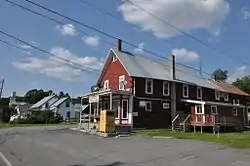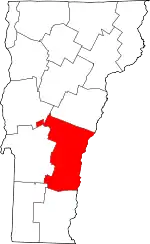West Hartford, Vermont
West Hartford is an unincorporated community village in the town of Hartford, Windsor County, Vermont. It is the most rural of Hartford's five villages, situated on the White River and crossed by the Appalachian Trail. Almost half of the village was wiped out by a flood in 1927. Some areas have been developed for residential use, but significant forest, farming and open lands remain. West Hartford features a country store, a post office, a small library and a town park along the White River which is a popular fishing site. The village center is listed on the National Register of Historic Places as the West Hartford Village Historic District.
West Hartford Village Historic District | |
 The former West Hartford Village Store | |
  | |
| Location | VT 14, Harper Savage Ln., Tigertown Rd., and Stetson Rd., Hartford, Vermont |
|---|---|
| Coordinates | 43°42′59″N 72°24′58″W |
| Area | 47 acres (19 ha) |
| Architectural style | Federal, Greek Revival |
| NRHP reference No. | 04001368[1] |
| Added to NRHP | December 15, 2004 |
Geography
West Hartford is located in far northern Hartford, seven river miles up the White River from its mouth at the Connecticut River. Its center is at geographical coordinates 43° 42′ 44" North, 72° 25′ 7" West (43.71212, -72.418541). The White River runs through the Village, and along Clifford Park, a great place for fishing and canoeing.
History
The West Hartford village was settled in the late 18th century, primarily organized around mills and outlying agricultural areas. The oldest surviving house in the village was built in 1795 by Francis and Abigail (Hazen) Savage; she was the granddaughter of the area's first colonial landowner. A turnpike, now Vermont Route 14, was built along the river in 1800. The focal center of the village was established at Harper Savage Lane by construction of the first bridge to span the White River in the village in 1820, and then by the construction of a railroad station nearby. By 1830 the village had a church and post office, and the village continued to thrive during the 19th century, mainly due to its proximity to White River Junction, one of the most important railroad hubs in the region. Much of the village was destroyed by a major flood in 1867. This eliminated much of the local industry, but retail presence, driven by the presence of the railroad, continued.[2]
In the spring of 1927 the Vermont rivers flooded, taking out several bridges, including the West Hartford bridge, then a covered bridge. Shortly after the flood the bridges were all replaced with "cookie cutter" bridges that were tall, green, steel truss bridges. In 2006 the West Hartford Bridge was replaced with a new single-span bridge, Veterans Bridge. The old bridge had a pool off the downstream side that local teens, children, and adults would jump off the bridge into the water. The new bridge is in a location where it is dangerous to jump because the deep pool is no longer accessible, though the teens, children, and adults still jump off the bridge. At the foot of the new bridge is a small area in remembrance of Hartford Veterans that have died in the wars.
Clifford Park is a town maintained park that includes nature trails, a softball field, horseshoe pits, and a picnic area on the river. Every summer, it is turned into a major landing area for the hot air balloons that have taken off at the Quechee Balloon Festival, and every Halloween it is the Haunted Area for local youths sponsored by the Hartford Parks and Recreation Department. The park is named Clifford, after the former owner of the land that now holds the park, and the land that is the Westfield Drive community.
On August 28, 2011 West Hartford was hit by Tropical Storm Irene. Several houses, the country store, the library, and the post office were affected. The post office was torn down, the store repaired, and the library has been rebuilt.
The bridge and road also suffered damage from this event. The bridge was out of commission for several weeks forcing people to find alternative routes to get to work and into more populated areas. As for the road, Route 14, it was usable to a certain point. It was repaired slowly and in the village itself there were several large holes where the river gouged away the pavement, dirt, and gravel.
The day after, August 29, people were out and about using their tractors and snowplows to clear Rt. 14 of mud and debris. While there were plenty of volunteers and they were very helpful and appreciated greatly, the people of West Hartford did not wait to be rescued; they rescued themselves.
The little white church became a place for workers, local, out of town, and even out of state, to get something to eat and drink and a place to relax for a while. The church was also used as a place for donated items and food to be collected for victims of Irene.
Clifford Park was a mess. It acquired at least a foot of mud and the playground, basketball half-court, tennis courts, and base ball field all had to be redone. Now the slide, swings, and tire swing are all back in place. There are picnic tables underneath a roof, benches stand here and there around the perimeter of the field, and the gravel parking lot is now outlined by a wooden fence.
It's cleaned up and repaired now, but you can still see the evidence of that day. Houses still bear the mark of Irene and that of people trying to fix the problems. You can still see where the river eroded the edges of the road and banks, underneath the patches that were put there.
Schools
West Hartford elementary students attend Ottoquechee School in Quechee, VT (K-5) and then attend middle and high school at Hartford Memorial Middle School (6-8) and Hartford High School (9-12). Families looking for their children to be in private school usually turn to the Upper Valley Waldorf School in Quechee (K-8), or Mid Vermont Christian School in Quechee (K-6) and the Middle School (7-8) and High School (9-12).
References
- "National Register Information System". National Register of Historic Places. National Park Service. March 13, 2009.
- Paula Sagermann (2004). "NRHP nomination for West Hartford Historic District". National Park Service. Retrieved 2016-09-05. with photos from 2004
External links
| Wikimedia Commons has media related to West Hartford Village Historic District. |
